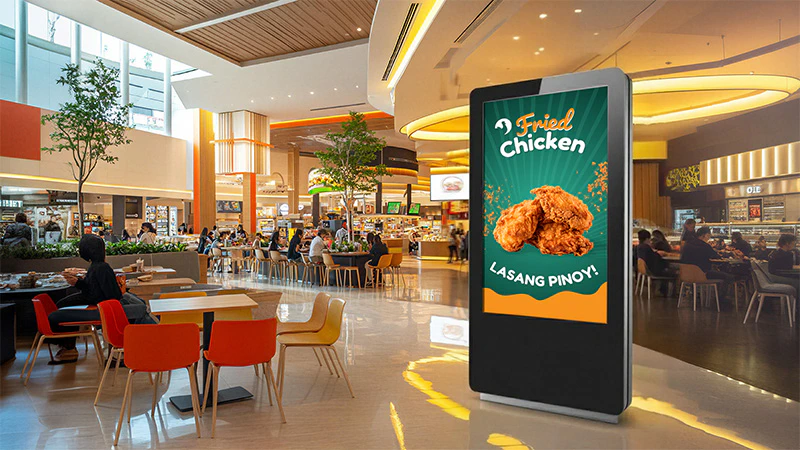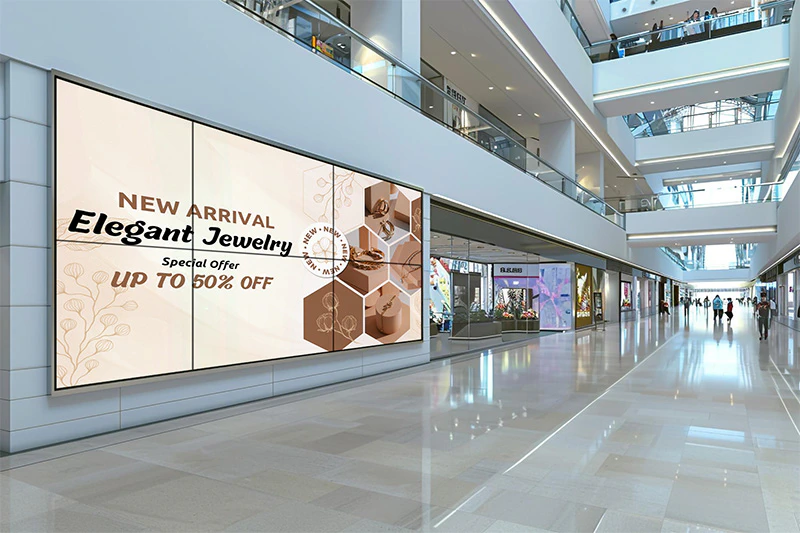How DOOH and Digital Signage Transform Shopping Centres

A shopping mall, also known as a shopping centre, is a large facility that contains many retail stores, restaurants, and entertainment options all located in one place.
Over time, shopping malls have changed from traditional retail places into social spots, entertainment areas, and lifestyle destinations. People now visit shopping malls not just to shop but also to meet, dine, and enjoy their time.
As customer expectations change, malls need to keep up with new trends. Regular static posters and printed banners are not enough anymore and can not compete with the impact of dynamic, visually captivating digital content. Digital signage makes malls more exciting and interactive.
In addition to enhancing the shopping experience, digital signage also serves as a powerful tool for advertising promotions, sharing important information, and guiding visitors through the mall.
Why Shopping Malls Need Digital Signage
Shopping malls use digital signage to communicate with shoppers and visitors. Mall managers and tenants can use digital signage screens to display welcoming messages, provide event updates, share store announcements, and highlight special sales and promotions from various brands across multiple displays.
These screens also guide visitors to their favourite stores, all managed through one easy-to-use digital signage platform like EasySignage. And that is not advertising, it’s a whole experience that keeps people informed and entertained, while providing valuable advertising opportunities.
Digital Out-Of-Home (DOOH) advertising helps retailers and advertisers increase their visibility and generate additional revenue through branded campaigns and sponsored content.
Top Benefits of Digital Signage for Shopping Malls
Digital signage brings a lot of advantages to shopping malls. It does more than just attract attention with its eye-catching visuals; it directly contributes to enhancing customer satisfaction and boosting revenue.
Increased Engagement:
Bright screens and dynamic content like motion graphics and videos grab attention better than static pictures. They help shoppers instantly notice promotions and important messages.
Better Shopping Experience:
Interactive screens and wayfinding displays make it easier for visitors to find stores, restaurants, and entertainment areas. Digital displays inform people about events happening in the mall, creating a smoother visit.
Advertising opportunities (DOOH):
Malls can sell space on their screens to businesses and brands, turning digital signage into a DOOH (Digital Out-of-Home) advertising channel that brings in extra money.
Real-time communication:
Instead of printing signs over and over, malls can update content in seconds by broadcasting updates about mall events, new services, promotions, in-store sales, and urgent safety information or emergency alerts.
Reduced Printing Costs:
Since everything is digital, malls save money on printing posters, banners, and flyers, while also being more eco-friendly.
Multi-screen management:
Mall managers can remotely control all screens across different zones of the mall or even multiple shopping centres from one digital signage content management system (CMS) dashboard. This saves time and reduces manual effort, and they can also schedule content to appear at optimal times.
Data and analytics:
Malls can track customer engagement, footfall, and dwell time to help them improve their advertising strategies.
Types of Digital Signage Displays for Shopping Malls
When it comes to choosing the right digital signage displays, shopping malls have plenty of options, each suited to different goals and locations:
Wall-mounted screens
These screens are fixed to the walls, making them ideal for use in corridors, entrances, or storefronts to display advertisements, promotions, and announcements.
Hanging displays
Suspended from the ceilings, these displays are often placed near escalators or in wide hallways. They are great for grabbing the attention of shoppers as they move between different floors and areas of the mall.
Digital menu boards
Placed in food courts, cafes and restaurants to display menus, prices, or daily special offers in real time.

Standing kiosks
These freestanding touch screens allow users to engage with content. They are perfect for directories, wayfinding, maps, or customer feedback.

Outdoor LED signage
Designed to withstand weather conditions, these high-brightness LED signage displays are great for atriums, outdoor façades, parking areas, and entrance gates where high visibility and brightness matter.
Video walls
Comprising multiple screens tiled together, video walls create a large, impactful display perfect for high-traffic areas.

DOOH displays
These large-scale digital billboards are used for mall advertising campaigns or for partner ads and promotions.
Touch-screen interactive panels
These touchscreen panels allow visitors to browse catalogues and products, locate stores, or sign up for loyalty programs.

By combining these display types, shopping malls can create a complete digital ecosystem that ensures every visitor touchpoint is dynamic, informative, and visually appealing.
Smart Feature: AI Audience Targeting
Although not a display type, EasySignage’s AI audience targeting feature significantly enhances any digital signage. This feature uses real-time analytics to show relevant content to different audiences. By employing smart cameras and real-time data to identify viewers’ demographics, like age group and gender, it automatically displays content that matches their interests. As a result, shoppers see more relevant ads, retailers get better results, and the mall boosts engagement without extra effort.
Read more about AI Digital Signage for DOOH Advertising.
How to Set Up Digital Signage for Shopping Malls and Retail Stores
Setting up digital signage in a mall or retail space is simple when you break it into steps:
1. Identify Key Screen Locations
Begin by selecting the right locations for your screens. Choose high-traffic areas such as entrances, escalators, food courts, hallways, or near top-performing stores to maximise visibility.
2. Select the Right Hardware
Pick the appropriate type of screen (wall-mounted, kiosk, LED, etc.) based on where it will be installed. For example, wall-mounted screens work well in narrow walkways, while large LED video walls are ideal for spacious areas. Your display should match the environment and blend seamlessly with the mall’s design.
3. Choose your Digital Signage Software
Pair your hardware with a reliable digital signage solution like EasySignage to manage content efficiently.
With its cloud-based platform, you can design, schedule, and publish content from any device, wherever you are, without on-site maintenance. Whether you’re managing ten screens or hundreds across multiple locations, EasySignage keeps everything synchronised and up to date.
Plus, it works across different platforms like Android, BrightSign, Tizen, Windows, and more, making it easy to integrate with any setup.
4. Create and Manage Content
After setting up your hardware and software, focus on designing eye-catching ads, wayfinding maps, or event updates that are tailored to your audience. You can use the EasySignage content editor or upload your own visuals from Canva or other tools.

5. Connect and Display on Screens
Finally, once everything is prepared, you can publish your content to the displays and monitor it directly from the cloud. With EasySignage, you can update or schedule new content anytime and from anywhere. Create automated playlists for daily promos, events, or seasonal campaigns. It is a simple and scalable solution designed to help your mall or store stand out.
6. User Management with EasySignage
EasySignage makes it easy to control who manages what. With secure multi-user access, you can give different tenants or brands access to manage their own content without interfering with other screens. Each user only sees and controls the content they’re responsible for, keeping everything organised and secure.
Conclusion
Digital signage is an essential tool for modern shopping malls and retail centres. It transforms regular spaces into interactive, engaging, and data-driven environments that attract visitors and enhance brand identity.
If you are looking to improve shopper navigation, promote sales, or generate advertising revenue through DOOH networks, EasySignage offers the reliable digital signage CMS you need.
Start transforming your mall today—sign up for free at manage.easysignage.com and see how our cloud-based digital signage software can improve your retail experience.